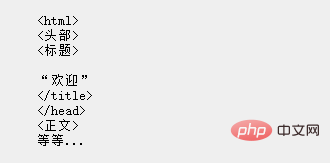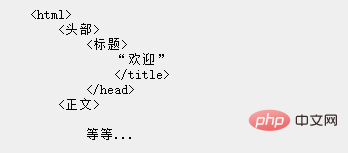what is htmlparser
htmlparser is a pure html parsing library written in java; htmlparser does not depend on other java library files. It is mainly used to transform or extract html. It can parse HTML in a linear or nested manner and can be understood as a Web information scraping tool.

The operating environment of this tutorial: Windows 10 system, HTML5 version, Dell G3 computer.
What does htmlparser mean?
htmlparser is a pure java-written html parsing library. It does not depend on other java library files. , mainly used to transform or extract html. It can parse html at super high speed without errors. The latest version of htmlparser is now 2.1. It is no exaggeration to say that htmlparser is currently the best tool for html parsing and analysis.
HTML Parser is a Java library for parsing HTML in a linear or nested manner. Mainly used for conversion or extraction, it has filters, visitors, custom tags and easy-to-use JavaBeans. It is a fast, powerful and well-tested package.
The two basic use cases handled by the parser are extraction and transformation (the synthesis use case, creating an HTML page from scratch, is best handled by other tools closer to the data source). While previous versions focused on extracting data from web pages, version 1.4 of HTMLParser has substantial improvements in converting web pages, simplifying the creation and editing of tags, and verbatim output of the toHtml() method.
In general, to use HTMLParser, you need to be able to write code in the Java programming language. Although some sample programs are provided that may be useful, you will most likely need (or want) to create your own or modify the provided programs to match your intended application.
To use this library, you need to add htmllexer.jar or htmlparser.jar to your classpath when compiling and running. htmllexer.jar provides low-level access to common string, comment, and label nodes on the page in a linear, flat, sequential manner. htmlparser.jar, which contains classes in htmllexer.jar, provides access to pages as nested distinguishing markup sequences containing strings, comments, and other markup nodes. Therefore, the output of calling the lexer nextNode() method may be:

The output of the parser NodeIterator will nest tags as ,
and others The children of the node (indicated here by indentation):
The parser tries to balance the opening and closing tags to present the structure of the page, while the lexer simply spits out node. If your application requires only modest knowledge of page structure and is primarily concerned with a single independent node, you should consider using a lightweight lexer. But if your application needs to understand the nested structure of the page, such as processing tables, you may want to use a full parser.
Recommended tutorial: "html video tutorial"
The above is the detailed content of what is htmlparser. For more information, please follow other related articles on the PHP Chinese website!

Hot AI Tools

Undresser.AI Undress
AI-powered app for creating realistic nude photos

AI Clothes Remover
Online AI tool for removing clothes from photos.

Undress AI Tool
Undress images for free

Clothoff.io
AI clothes remover

AI Hentai Generator
Generate AI Hentai for free.

Hot Article

Hot Tools

Notepad++7.3.1
Easy-to-use and free code editor

SublimeText3 Chinese version
Chinese version, very easy to use

Zend Studio 13.0.1
Powerful PHP integrated development environment

Dreamweaver CS6
Visual web development tools

SublimeText3 Mac version
God-level code editing software (SublimeText3)

Hot Topics
 1386
1386
 52
52
 Table Border in HTML
Sep 04, 2024 pm 04:49 PM
Table Border in HTML
Sep 04, 2024 pm 04:49 PM
Guide to Table Border in HTML. Here we discuss multiple ways for defining table-border with examples of the Table Border in HTML.
 HTML margin-left
Sep 04, 2024 pm 04:48 PM
HTML margin-left
Sep 04, 2024 pm 04:48 PM
Guide to HTML margin-left. Here we discuss a brief overview on HTML margin-left and its Examples along with its Code Implementation.
 Nested Table in HTML
Sep 04, 2024 pm 04:49 PM
Nested Table in HTML
Sep 04, 2024 pm 04:49 PM
This is a guide to Nested Table in HTML. Here we discuss how to create a table within the table along with the respective examples.
 HTML Table Layout
Sep 04, 2024 pm 04:54 PM
HTML Table Layout
Sep 04, 2024 pm 04:54 PM
Guide to HTML Table Layout. Here we discuss the Values of HTML Table Layout along with the examples and outputs n detail.
 HTML Input Placeholder
Sep 04, 2024 pm 04:54 PM
HTML Input Placeholder
Sep 04, 2024 pm 04:54 PM
Guide to HTML Input Placeholder. Here we discuss the Examples of HTML Input Placeholder along with the codes and outputs.
 HTML Ordered List
Sep 04, 2024 pm 04:43 PM
HTML Ordered List
Sep 04, 2024 pm 04:43 PM
Guide to the HTML Ordered List. Here we also discuss introduction of HTML Ordered list and types along with their example respectively
 Moving Text in HTML
Sep 04, 2024 pm 04:45 PM
Moving Text in HTML
Sep 04, 2024 pm 04:45 PM
Guide to Moving Text in HTML. Here we discuss an introduction, how marquee tag work with syntax and examples to implement.
 HTML onclick Button
Sep 04, 2024 pm 04:49 PM
HTML onclick Button
Sep 04, 2024 pm 04:49 PM
Guide to HTML onclick Button. Here we discuss their introduction, working, examples and onclick Event in various events respectively.




